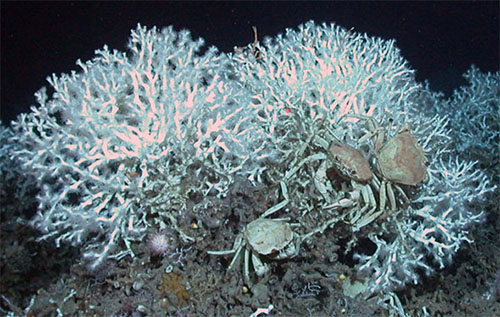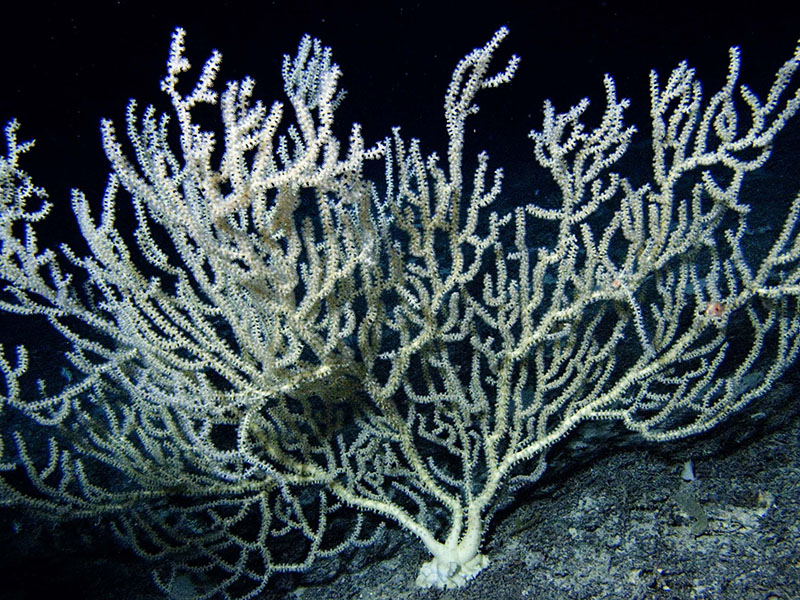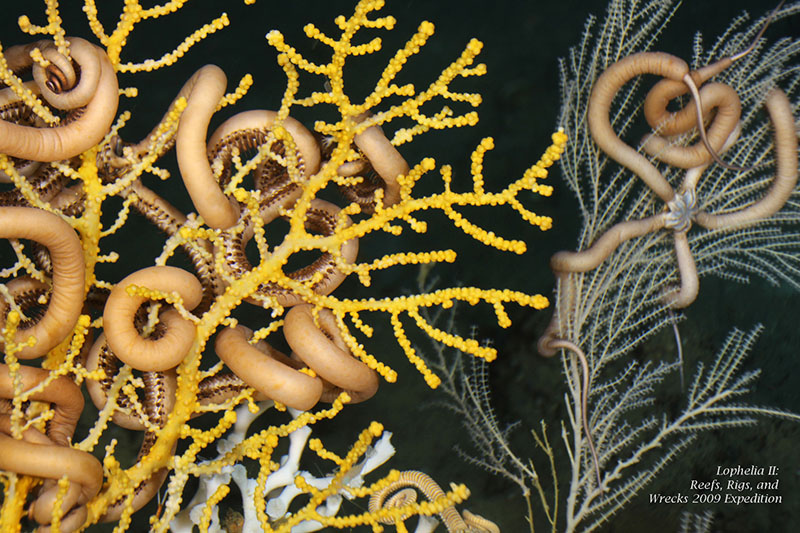
By Sandra Brooke, Florida State University

Lophelia reef on the west Florida slope with several golden crabs scavenging on the dead coral matrix. Image courtesy of BOEM/USGS 2010. Download larger version (jpg, 88 KB).
When we think of coral reefs, images of clear, warm water; gently swaying sea fans; and brightly colored fish tend to spring to mind. The coral reefs that we will be exploring during this expedition live in very different habitats from shallow reefs, but are remarkably similar in many ways.

Photograph of a large colony of a deep-sea bamboo coral taken south of Florida. The coral colony was over one meter wide. Image courtesy of NOAA-OER 2005. Download larger version (jpg, 2.1 MB).
Deep-sea corals are defined as corals that live at depths greater than 50 meters, but most species live in depths several hundred meters deep, in cold, dark, rocky habitats, often far from shore. Unlike shallow-water coral reefs, which are limited to warm tropical waters, deep-sea corals are found throughout the world’s oceans, from tropical to polar regions. Like their shallow counterparts, deep-sea reefs are created by stony corals that form large geological structures over thousands of years.
While the diversity of corals that build reefs in shallow waters is very high, and includes hundreds of species, there are only six species of deep-sea stony corals that create reefs. The most common of these is Lophelia pertusa, which forms massive reefs throughout the Atlantic Ocean, including the Gulf of Mexico and the South Atlantic Bight.

This image shows a diversity of deep-sea coral species, including two species of octocorals, or sea fans (Paramuricea in yellow and Callogorgia in light gray), one species of stony coral (Lophelia pertusa in white), and a brittle star (Asteroschema). Image courtesy of Lophelia II: Reefs, Rigs, and Wrecks 2009 Expedition, NOAA OER/BOEM. Download larger version (jpg, 1.3 MB).
Shallow-water corals rely on photosynthetic algae that live within the corals and provide their hosts with nutrition. However, algae cannot survive where there is no light, so deep-sea corals need to rely on alternate sources of food to obtain their nutrition, either by feeding on organic material falling from the surface or by feeding on small plankton. Because deep-sea corals lack algae, they are bright white in coloration, rather than the brown and green colors than we see in shallow reefs. Other types of corals such as gorgonians, black corals, and soft corals, add diversity and color to deep-sea coral ecosystems.
As with shallow reefs, the structure created by deep-sea corals provides habitat for diverse communities of other invertebrates and fishes, some of which are economically valuable. The demise of shallow coral reefs from anthropogenic impacts has been documented for many years, and despite their extreme depths and distance from shore, deep-sea corals are not unaffected from human impacts.
As coastal resources become depleted, humans have begun to move deeper in search of new sources of food and energy. The greatest impact to deep-sea corals comes from commercial bottom trawls, which use heavy gear to harvest deep-sea fishes and in the process, damage structures that grow on the seafloor, such as deep-sea corals. This type of fishing has devastated large areas of deep-sea reefs in both national and international waters.
Corals are also harvested directly for their black, red, or gold skeletons, which are used to make jewelry and ornaments. These ‘precious corals’ are known to be ancient and slow growing – in fact the oldest known animal on Earth was a black coral that has been dated to over 4,250 years old.

Deep-sea black coral, Leiopathes glaberrima, with commensal galatheoid crab photographed at 300 meters depth in the Gulf of Mexico. Individuals of this species have been dated to be over 2,000 years old, thereby making them some of the oldest known marine species. Image courtesy of Lophelia II: Reefs, Rigs, and Wrecks 2009 Expedition, NOAA OER/BOEM. Download larger version (jpg, 127 KB).
Deep-sea corals are often found in areas of oil and gas operations, so there is potential for damage from drilling muds and oil spills. Deep-sea mining is fast becoming a reality, with vast areas of the high seas leased for exploration. These mining machines are large and may permanently remove large areas of deep-sea coral habitat. In addition, future impacts from climate change are not well understood, but increasing temperatures may shift species’ distributions and increasing acidity may weaken coral skeletons, particularly in deeper waters where the impacts of ocean acidification are thought to be greatest.
Most of the deep coral research in the Gulf of Mexico has focused on the northern region, which is where energy interests are focused, but the eastern Gulf is relatively unexplored. One of the primary objectives of this expedition is to explore and describe deep-sea coral communities on the west Florida slope. Earlier surveys in this area discovered abundant and thriving Lophelia reefs, as well as aggregations of large black corals. However, multibeam surveys have revealed vast areas where there are many other promising features that have never been explored.
Some of the known coral habitats have been proposed as habitat areas of particular concern (HAPC) and any additional information we can provide will help support this process, as well as other management and conservation actions. While creating new protected areas cannot completely prevent damage from oil spills or climate change, these areas can improve the health and resilience of corals in the face of future threats.